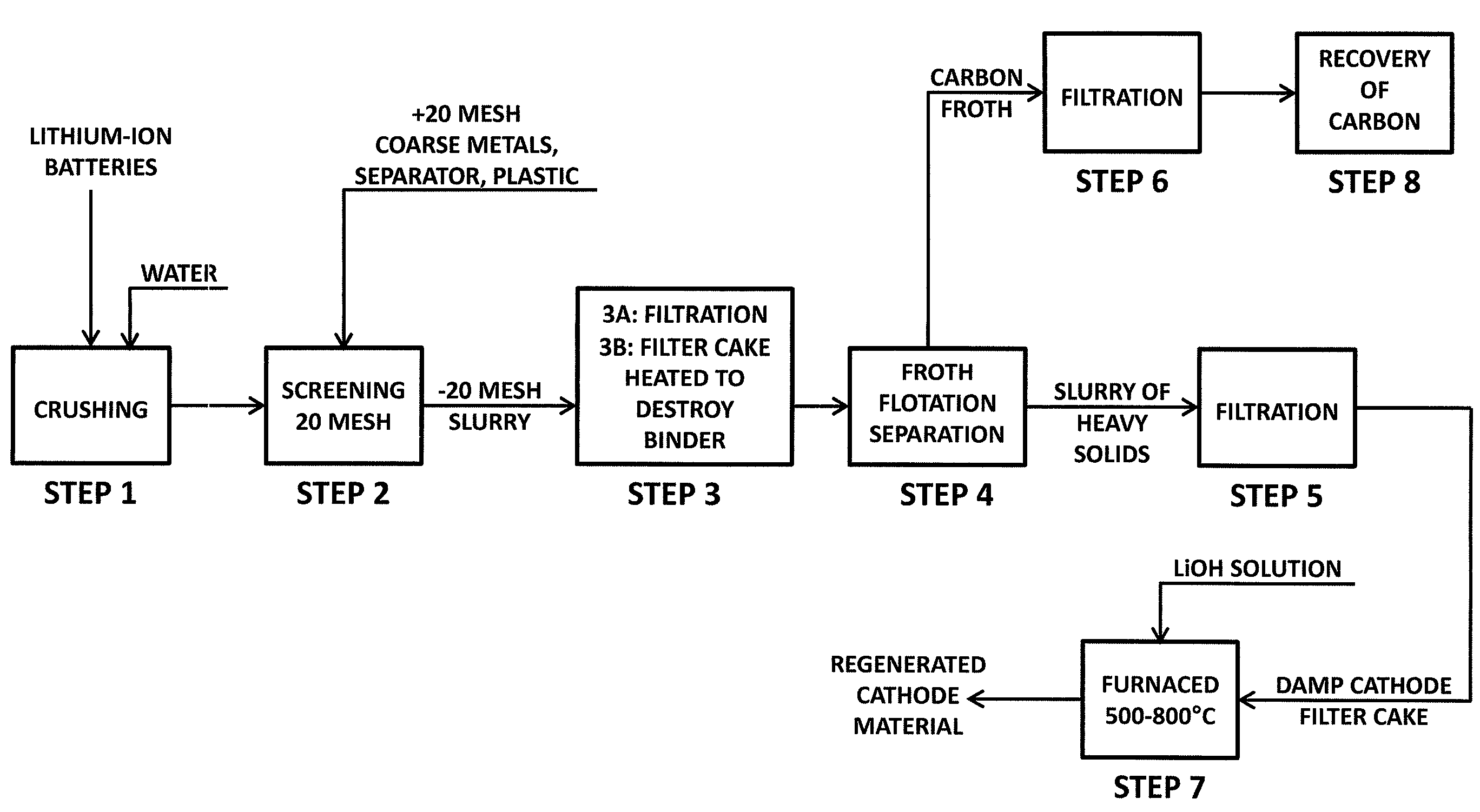Recovery of lithium ion batteries
a lithium ion battery and lithium metal oxide technology, applied in secondary cell servicing/maintenance, cell components, electrochemical generators, etc., can solve the problems of no recovery of lithium metal oxide, loss of full value of lithium metal oxide cathode material,
- Summary
- Abstract
- Description
- Claims
- Application Information
AI Technical Summary
Benefits of technology
Problems solved by technology
Method used
Image
Examples
example 1
[0036]Lithium-ion batteries containing lithium cobaltate as the cathode material were run through a hammer mill in plant production and screened through −25 mesh slot screen. The slurry was then filtered and the damp filter cake heated in a furnace to 500° C. for 1 hour with some air present to modify the carbon surface and destroy the binder and then cooled. The cake was approximately 35% Co.
[0037]The dried furnaced cake was wet screened through a US #140 mesh (106 micron) screen and then 100 g of this screened solid (on a dry basis) was made up to one liter volume with water (10% solids). This 10% slurry was then added to a Metso Denver D-12 Flotation unit with a one liter flotation cell. The slurry was stirred and a small amount of glacial acetic acid was added to adjust to pH 5 and then 1% kerosene and 0.5% methyl isobutyl carbinol were added as flotation and foaming aids. Air (or nitrogen) was slowly run through the stirring shaft with stirring to produce a stable foam. The air...
example 2
[0040]Lithium-ion batteries containing lithium nickel cobaltate (LiCo0.5Ni0.5O2) as the cathode material were run through a hammer mill in plant production and screened through −25 mesh slot screen. The slurry was then filtered and the damp filter cake heated in a furnace to 500° C. for 1 hour with some air present to modify the carbon surface and destroy the binder and then cooled. The cake was approximately 17% Co and 17% Ni by weight.
[0041]The dried furnaced cake was wet screened through a US #140 mesh (106 micron) screen and then 100 g of this screened solid (on a dry basis) was made up to one liter volume with water (10% solids). This 10% slurry was then added to a Metso Denver D-12 Flotation unit with a one liter flotation cell. The slurry was stirred and a small amount of glacial acetic acid was added to adjust to pH 5 and then 1% kerosene and 0.5% methyl isobutyl carbinol were added as flotation and foaming aids. Air (or nitrogen) was slowly run through the stirring shaft wi...
example 3
[0044]The lithium-ion batteries containing lithium nickel cobaltate (LiCo0.33Ni0.33Mn0.33O2) as the cathode material were run through a hammer mill in plant production and screened through −25 mesh slot screen. The slurry was then filtered and the damp filter cake heated in a furnace to 500 C. for 1 hour with some air present to modify the carbon surface and destroy the binder and then cooled. The cake was approximately 11% Co, 12% Mn, and 12% Ni by weight.
[0045]The dried furnaced cake was wet screened through a US #140 mesh (106 micron) screen and then 100 g of this screened solid (on a dry basis) was made up to one liter volume with water (10% solids). This 10% slurry was then added to a Metso Denver D-12 Flotation unit with a one liter flotation cell. The slurry was stirred and a small amount of glacial acetic acid was added to adjust to pH 5 and then 1% kerosene and 0.5% methyl isobutyl carbinol were added as flotation and foaming aids. Air (or nitrogen) was slowly run through t...
PUM
 Login to View More
Login to View More Abstract
Description
Claims
Application Information
 Login to View More
Login to View More - R&D
- Intellectual Property
- Life Sciences
- Materials
- Tech Scout
- Unparalleled Data Quality
- Higher Quality Content
- 60% Fewer Hallucinations
Browse by: Latest US Patents, China's latest patents, Technical Efficacy Thesaurus, Application Domain, Technology Topic, Popular Technical Reports.
© 2025 PatSnap. All rights reserved.Legal|Privacy policy|Modern Slavery Act Transparency Statement|Sitemap|About US| Contact US: help@patsnap.com


